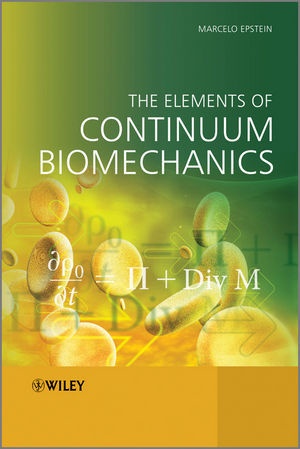Read more
Informationen zum Autor Marcelo Epstein is Professor of Mechanical and Manufacturing Engineering and Adjunct Professor of Kinesiology at the University of Calgary. He is a fellow of the American Academy of Mechanics, recipient of the CANCAM prize and University Professor of Rational Mechanics. Klappentext An appealing and engaging introduction to Continuum Mechanics in BiosciencesThis book presents the elements of Continuum Mechanics to people interested in applications to biological systems. It is divided into two parts, the first of which introduces the basic concepts within a strictly one-dimensional spatial context. This policy has been adopted so as to allow the newcomer to Continuum Mechanics to appreciate how the theory can be applied to important issues in Biomechanics from the very beginning. These include mechanical and thermodynamical balance, materials with fading memory and chemically reacting mixtures.In the second part of the book, the fully fledged three-dimensional theory is presented and applied to hyperelasticity of soft tissue, and to theories of remodeling, aging and growth. The book closes with a chapter devoted to Finite Element analysis. These and other topics are illustrated with case studies motivated by biomedical applications, such as vibration of air in the air canal, hyperthermia treatment of tumours, striated muscle memory, biphasic model of cartilage and adaptive elasticity of bone. The book offers a challenging and appealing introduction to Continuum Mechanics for students and researchers of biomechanics, and other engineering and scientific disciplines.Key features:* Explains continuum mechanics using examples from biomechanics for a uniquely accessible introduction to the topic* Moves from foundation topics, such as kinematics and balance laws, to more advanced areas such as theories of growth and the finite element method..* Transition from a one-dimensional approach to the general theory gives the book broad coverage, providing a clear introduction for beginners new to the topic, as well as an excellent foundation for those considering moving to more advanced application Zusammenfassung An appealing and engaging introduction to Continuum Mechanics in Biosciences This book presents the elements of Continuum Mechanics to people interested in applications to biological systems. It is divided into two parts, the first of which introduces the basic concepts within a strictly one-dimensional spatial context. Inhaltsverzeichnis Dedication ix Preface xi Part One A one-dimensional context 1 1 Material bodies and kinematics 3 1.1 Introduction 3 1.2 Continuous vs. discrete 6 1.3 Configurations and deformations 9 1.4 The deformation gradient 14 1.5 Change of reference configuration 15 1.6 Strain 16 1.7 Displacement 18 1.8 Motion 19 1.9 The Lagrangian and Eulerian representations of fields 22 1.10 The material derivative 24 1.11 The rate of deformation 26 1.12 The cross section 27 2 Balance laws 29 2.1 Introduction 29 2.2 The generic Lagrangian balance equation 30 2.2.1 Extensive properties 30 2.2.2 The balance equation 31 2.3 The generic Eulerian balance equation 35 2.4 Case study: Blood flow as a traffic problem 37 2.5 Case study: Diffusion of a pollutant 39 2.5.1 Derivation of the diffusion equation 39 2.5.2 A discrete diffusion model 41 2.6 The thermo-mechanical balance laws 42 2.6.1 Conservation of mass 42 2.6.2 Balance of (linear) momentum 43 2.6.3 The concept of stress 44 2.7 Case study: Vibration of air in the ear canal 45 2.8 Kinetic energy 50 2.9 The thermodynamical balance laws 55 2.9.1 Introduction 55 2.9.2 Balance of energy 56 2.9.3 The entropy inequality 58 2.10 Summary of balance equati...

